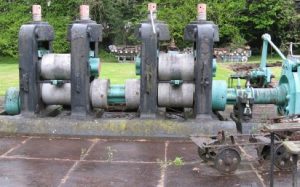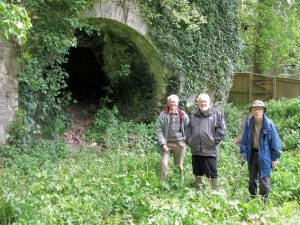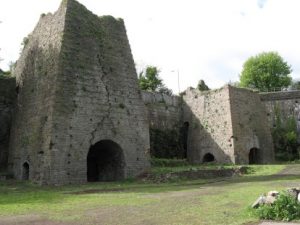Travelling to South Wales on a Friday means contending with week-end traffic so our first visit commenced at 3pm at the kind invitation of Tata Steel (Europe). This was to the Trostre Tinplate plant in Llanelli where, after an introduction to the manufacture and uses of tinplate, we were condu

cted around the plant by the MD, Joe Gallacher. Hot rolled coil arrives from the nearby steel plant at Port Talbot and is rolled to thin strip at Trostre, 0.5mm or so thick. Following annealing, the strip is cleaned and passes continuously through the tinning line where tin is electrolytically deposited onto the steel. The two tinning lines in operation have a combined capacity of 0.4 million tonnes a year and an additional line plates chromium instead of tin. A coil painting line is also in operation.
The works has also preserved a small museum showing the former method of pack-mill tinplate production which once made South Wales the leading exporter of tinplate world-wide. More about this later.
Next, we drove to our accommodation, the Travelodge at Cross Hands a few miles N of Llanelli. Dinner was taken in a local pub.

In a change to the planned itinerary, the next morning we visited Alexander Raby’s furnace on the edge of Llanelli. Alexander Raby started his career on the Weald managing Warren Furnace for his father before setting out independently to open ‘iron mills’ in Surrey and Derbyshire. He moved to Llanelli in 1796, taking over the blast furnace and coal mines there. Sadly, interests in the Carmarthenshire Rail Company resulted in his bankruptcy in 1820.
In the afternoon we drove to Neath to visit the Aberdulais tinplate remains. Now owned by the National Trust we were given a private tour of the remaining foundations as well as visiting its famous water fall and water wheel, a modern replica now generating power for the site and National Grid. The first business here was copper smelting using ore delivered via boat from Cornwall. Over the years the site was successively used as an ironworks, a corn mill and a tinplate works. Tinplate from Aberdulais was exported around the world, and Welsh tinplate output dwarfed the production of any place elsewhere in the world. Unfortunately, the very success of the Welsh tin plate industry brought about its downfall, when the American government put heavy import duties on imported tinplate, and the Welsh industry collapsed. So Trump’s 25% import tariff on British steel is not the first!

This was followed by a visit to nearby Neath Abbey ironworks. Not normally open to the public, a private tour enabled us to inspect its two massive blast furnaces, built in 1793, and engineering works where stationary steam engines and ship engines were among its many engineering achievements.
Returning to our hotel, we again dined in the local pub.
On Sunday, we checked out of our accommodation and proceeded to Kidwelly Industrial Museum. This is believed to be the only surviving pack-mill with most of its equipment still intact. Owned by Carmarthenshire Council, sadly this well interpreted museum is no longer generally open to visitors but, with a reasonable donation, we were again given a private tour. Opened in 1737 and worked until 1941, the works hand rolled bars of wrought iron into sheets, doubling up the sheets by folding them over up to eight times – hence the name ‘pack mill’ – in order to produce sufficiently thin sheets within the limits of the small hand mills of the day. Cropping the ends enabled the sheets to be separated, then cleaned and tinned by dipping in molten tin.
Heading east towards the M4, we stopped at Merthyr Tydfil to visit the Cyfarthfa ironworks where six of the later 19C blast furnaces remain. Established in 1765 by Anthony Bacon, the works was initially the largest of four works in the town. The coke fired furnaces used a water wheel to drive cylinder blowers, some of the water arriving via the earliest surviving cast iron bridge carrying a leat and tramway over the river Taff to the works. In 1884 a Bessemer steelworks was added and in 1902 Cyfarthfa was sold to Guest, Keen & Nettlefolds Ltd (GKN) who also owned the nearby competitor, Dowlais Ironworks. The works closed in 1919.
The final visit of the day was to Cyfarthfa Castle built in 1824 to overlook the works by the then owner, William Crawshay. Today the Castle houses a museum and art gallery, several rooms of which are dedicated to Merthyr’s ironworking heritage.
